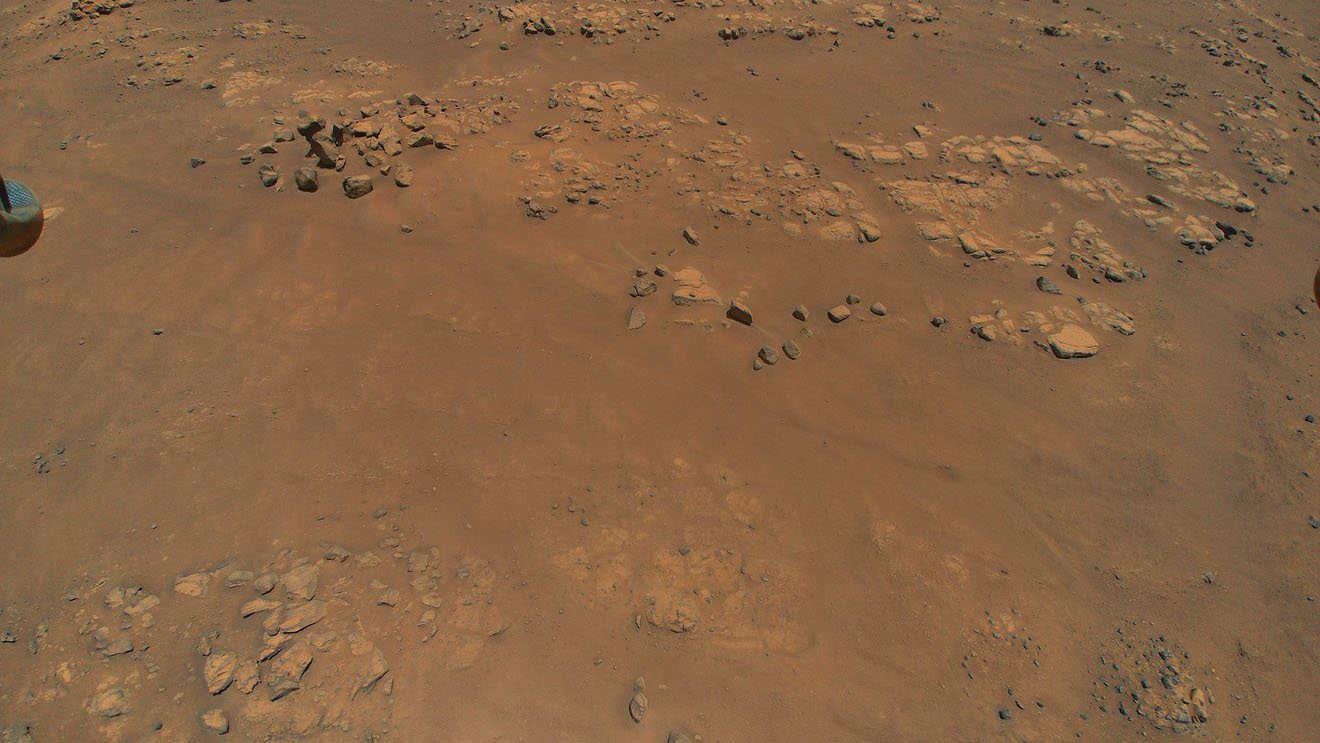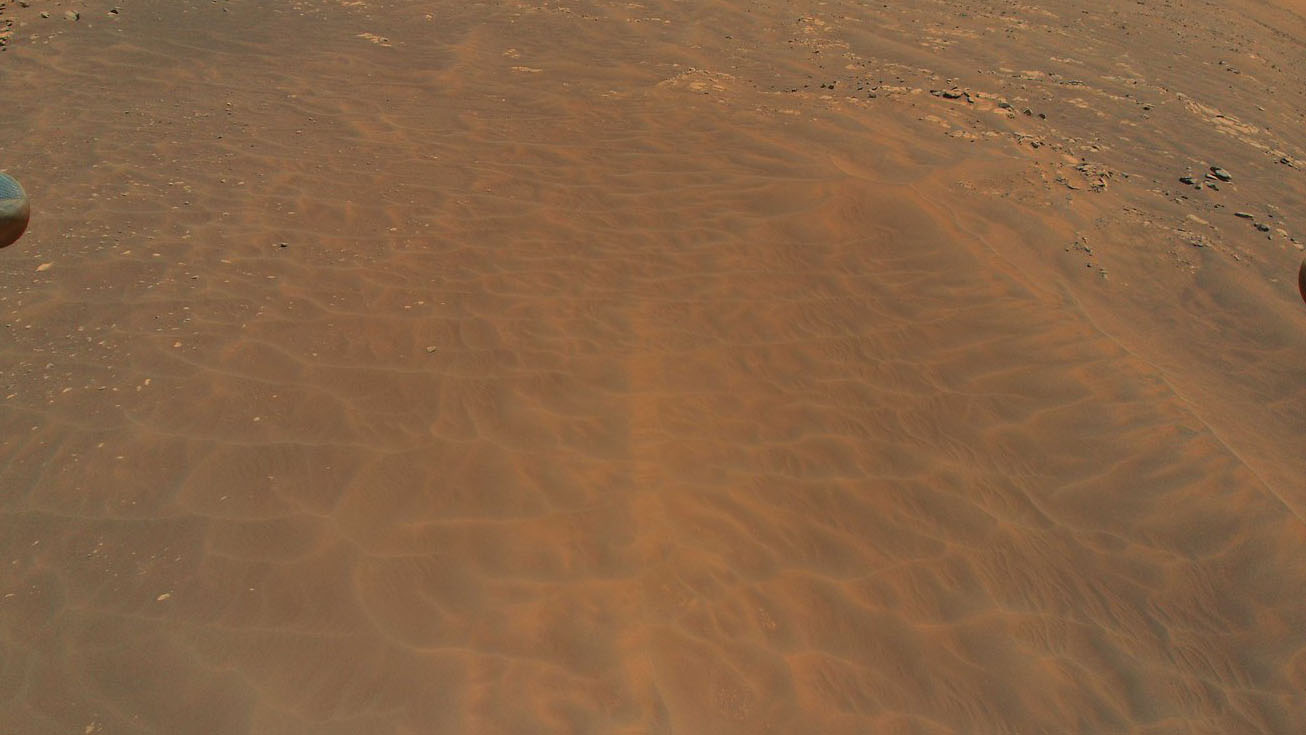New photos from the Mars helicopter Ingenuity's 9th flight help refine Perseverance rover science goals
Images taken by the Ingenuity helicopter reveal details of the surface of Mars that can't be seen with orbiting cameras.

A new batch of images taken by the Ingenuity helicopter during its recent flight over the surface of Mars is helping NASA scientists to refine science goals for the Perseverance rover and chart the best route forward as they search for signs of life on the Red Planet.
The color images, downlinked on Thursday (July 8) following Ingenuity's ninth flight, show the surface of Jezero Crater, the landing site of the Perseverance rover, from an altitude of merely 33 feet (10 meters). The images allow scientists to see much smaller terrain features, such as individual boulders and rocks, than are visible in the images from Mars orbiters that are usually used for planning the route of the rover. For example, NASA's High Resolution Imaging Science Experiment, a camera aboard the Mars Reconnaissance Orbiter, provides a resolution of 3 feet (1 m). To get to a finer level of detail, the teams would have to use the rover itself.
"Once a rover gets close enough to a location, we get ground-scale images that we can compare to orbital images," Perseverance Deputy Project Scientist Ken Williford of the NASA Jet Propulsion Laboratory (JPL) in California said in a statement. "With Ingenuity, we now have this intermediate-scale imagery that nicely fills the gap in resolution."
Related: Watch NASA's Mars helicopter Ingenuity fly in 3D (video)
The images, taken on July 5, show some features that are of great interest to scientists hoping to find traces of past or present life in Jezero Crater. The so-called Raised Ridges are rock features that, scientists believe, used to serve as underground water channels in the past. As life is more likely to exist in the presence of water, the scientists are looking to collect samples of material from these ridges that could be taken to Earth with a future sample return mission.
"Our current plan is to visit Raised Ridges and investigate it close up," Williford said. "The helicopter's images are by far better in resolution than the orbital ones we were using. Studying these will allow us to ensure that visiting these ridges is important to the team."
During its last flight, Ingenuity also flew over the Séítah dune field, which the Perseverance rover is expected to drive past. But with a sand layer that can be over 3 feet deep in places, the dunes present a potential trap for the six-wheeled rover.
Get the Space.com Newsletter
Breaking space news, the latest updates on rocket launches, skywatching events and more!
"Sand is a big concern," Olivier Toupet, a Perseverance driver at JPL said in the statement. "If we drive downhill into a dune, we could embed ourselves into it and not be able to get back out."



Sand dunes are tricky even for the new Perseverance AutoNav feature, which uses artificial intelligence to autonomously drive the rover across great distances, Toupet added. Although the feature can avoid rocks, it struggles to detect sand dunes. The new Ingenuity images will thus help the ground operators better identify the high-risk zones in and around the dune field.
"The helicopter is an extremely valuable asset for rover planning because it provides high-resolution imagery of the terrain we want to drive through," said Toupet. "We can better assess the size of the dunes and where bedrock is poking out. That's great information for us; it helps identify which areas may be traversable by the rover and whether certain high-value science targets are reachable."
The latest images, unfortunately, revealed that the Séítah field would be too risky for Perseverance to attempt any bolder scientific exploration. The ground-control teams, however, can use the images to better plan scientific operations in other dune fields that the rover is going to explore in the future, NASA said in the statement.
Follow Tereza Pultarova on Twitter @TerezaPultarova. Follow us on Twitter @Spacedotcom and on Facebook.
Join our Space Forums to keep talking space on the latest missions, night sky and more! And if you have a news tip, correction or comment, let us know at: community@space.com.

Tereza is a London-based science and technology journalist, aspiring fiction writer and amateur gymnast. Originally from Prague, the Czech Republic, she spent the first seven years of her career working as a reporter, script-writer and presenter for various TV programmes of the Czech Public Service Television. She later took a career break to pursue further education and added a Master's in Science from the International Space University, France, to her Bachelor's in Journalism and Master's in Cultural Anthropology from Prague's Charles University. She worked as a reporter at the Engineering and Technology magazine, freelanced for a range of publications including Live Science, Space.com, Professional Engineering, Via Satellite and Space News and served as a maternity cover science editor at the European Space Agency.









